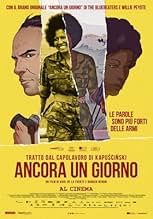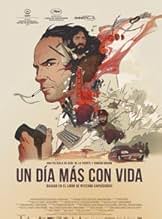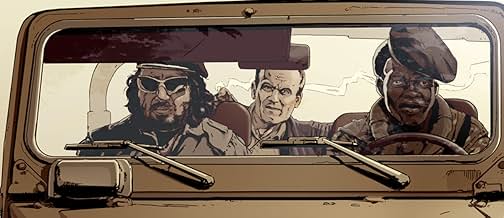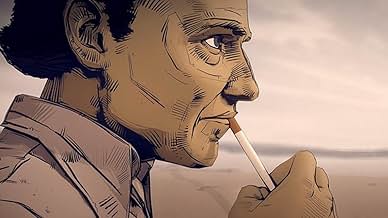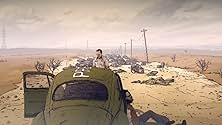Le captivant voyage de trois mois parcouru par le célèbre journaliste polonais Ryszard Kapuscinski à travers l'Angola ravagé par une guerre dans laquelle les lignes de front se sont déplacée... Tout lireLe captivant voyage de trois mois parcouru par le célèbre journaliste polonais Ryszard Kapuscinski à travers l'Angola ravagé par une guerre dans laquelle les lignes de front se sont déplacées comme un kaléidoscope d'un jour à l'autre.Le captivant voyage de trois mois parcouru par le célèbre journaliste polonais Ryszard Kapuscinski à travers l'Angola ravagé par une guerre dans laquelle les lignes de front se sont déplacées comme un kaléidoscope d'un jour à l'autre.
- Réalisation
- Scénario
- Casting principal
- Récompenses
- 14 victoires et 9 nominations au total
- Self
- (as Luis Alberto)
- Self
- (images d'archives)
- (as Carlota)
- Self
- (as Farrusco)
- Queiroz
- (as Vergil Smith)
- …
- Queiroz
- (voix)
- Farrusco
- (voix)
- Carlota
- (voix)
- Friedkin
- (voix)
- …
- Dona Cartagina
- (voix)
Avis à la une
The animated sections are in the English language and the actual documentary pieces are in native tongues; but there are subtitles available so that you know what is said. It makes for a gripping and most thoroughly interesting watch and, is presented in an almost comic style very polished looking animated style. There is no one sided reporting as it tells the tale of the misery caused by both side and both superpowers; a misery that endured for the Angolan people for 27 years.
And, while it's been a really long time since I've seen that film, the ghost it left behind inside of me, with its visuals and story ruminating within my mind consciously and my spirit subconsciously, there's a lot of shared DNA here. Tragedy. The cruel inescapability of war and conflict in the human experience and the human emotional response to those forces. The surreal, dreamlike imagery. But the most crucial thing might be where they depart.
See, Waltz was a very tight, coherent story. It flowed smoothly and was paced well and it was centered around a dark truth from the past and how crimes against humanity never merely pass into nothingness, they continue to echo both within those misfortunate enough to have survived or taken part in them, but also in a tragically karmic way, of continuing the cycle of violence and hatred in a perpetual dance of misery between the victim and the oppressor as the roles change hands. In that film it is the recognition of this fact amidst a recognition of shared humanity that challenges the viewer to slowly unravel it and eventually come face to face with the Other as Self and see the Self as Other.
I only wish Another Day of Life was so well put together and envisioned. It's full of brave, bold choices, not the least of which is blending documentary content (interviews, real-world photos and shots) with the animation throughout the film. This is something I've never seen done in this way, and it really did strike me as creatively brilliant. But it also held this film back from being its best self. The filmmakers seem to be trying to convey something here, as we the audience get routinely pulled out of the narrative, often with little warning or with abrupt transitions, to see one of our characters in real life at present day, giving their own narrative account of the events. This gives the film a kind of authenticity few others ever carry and give it something perhaps even rarer: a real sense of PERSPECTIVE.
But with perspective, comes bias. And, for me, not being at all well-versed in the subject matter, I found myself starting to feel that bias as unsettling. Losing objectivity is one thing, but it's another to start feeling one has to question accuracy and truth. What's the other side of the story, I wondered. Surely, the real world rarely gives us examples of such a simplistic narrative as "MPLA as goodguys, FLNA/UNITA as badguys". Surely all parties had their own interests, motivations, and agency beyond simply being manipulated by the Western or Soviet Blocs... and yet, we get none of that context here. We simply see the struggle as it was experienced by the characters. I think a more self-aware film might have attempted to predict and preempt this viewer reaction, but perhaps it would not be faithful to the source material then-I don't know, as I haven't read the book upon which this is based.
In any case, beyond the questions of rationalist viewers' minds who might start having their "propaganda/politics alarms" going off, there's a far more practical problem that this format introduces: that it is ver jarring to the audience to be pulled in and out of a narrative. This might have been eased if the editing were done to make the transitions smoother, but it almost felt like the intention was the opposite: to intentionally jolt us, as if to say "don't get caught up in hearing a good story... do not forget that this is not just a story, it is of real people and their lives". And to that, I must simply bow my head, because it certainly had that effect on me. It took me out of the excitement, the drama, all of it, and brought me back, face-to-face, again and again with the sobering reminder that this was real. For, there were the real people... those still alive to speak to their experience. That is something that all too often gets lost in this kind of film, as we watch events unfold in detachment, even if we know they are rooted in reality. To suddenly hear the words of that same character speaking to the camera and explaining it... well that is another thing. I applaud the bravery to go this route.
Still, not everyone is going to enjoy the experience, for it is not made to be enjoyed, and perhaps maybe that is the way such films should be made. It is not for us to feel good, have a happy ending, or retain our sense of safety and detachment. This film wants us to recognize there is something deep here about human nature and perhaps just about nature itself and how the world works, that when the chaos comes, we cannot always escape it. We can choose whether or not to participate in it... and what part to play or which side to be on, and then make the choices we can where we can, and if we are very lucky they might be ones that have a chance to shift the course of events. But nevertheless, we mostly just survive it. Or not. And the film wants us to know that these times are not things that only exist "over there", or even just "out there", they are everywhere and they will always come again, and yes, too, they even extend inside of us, as battles that rage within our hearts and minds and our souls as we are forced to choose and to act within such events. I was reminded of the saying, though I cannot recall its source or veracity: "people think they make history, but it is often the other way around".
So, maybe the disjointed feeling of the edits and style are there for a reason, or maybe I'm just making up reasons that act as excuses to an unpolished presentation... I don't know. But the situation is not helped by the constant injection of surrealism and dream sequences that border on magical realism at times. This too might have artistic merit and may well represent a unique voice. And if you are open to that kind of thing you will enjoy it. But, objectively, it does not help the film move along and work together AS A FILM. And so, if you are going into this expecting just a good, straight-forward animated story, you might be put off but something that at times feels like you went from watching the Killing Fields or Apocalypse Now to the Science of Sleep. If symbolic representations of the deconstruction of a character and their world in the midst of key scenes make you roll your eyes, you may want to pass on this one. If that sounds intriguing and worth a look, put this higher up your list. If you're open to it, but skeptical, just be aware going in so you don't try to put this on for a group that isn't going to appreciate it.
So, if you are up for it, this is a thought-provoking film and might be the beginning of a good deal more reading for you as you attempt to sift through sources and authorities and try to judge how biases or balanced the accounts might be. You are in for something that will impact you and make you think, and there are some truly gut wrenching and tear-worthy moments, as well as some heart-warming ones. You'll be left conflicted, but it will feel appropriate and earned. Unless you turned the film off after the 7th time animation abruptly gave way to a real-life interview, or our main character suddenly flying through space yet again left you wondering what the hell was actually going on. Any true voice is neither unbiased, nor balanced.... But has something perhaps even more worth your listening if you give it the chance.
The film is well based on historical events , these are as follows : The country is in the midst of decolonization efforts, launched after the success of the Carnation Revolution. Portuguese nationals are hurriedly fleeing the more glamorous districts of Luanda. The war devastated Angola's infrastructure and severely damaged public administration, the economy and religious institutions.In the final months before the declaration of independence, different factions of the Angolan liberation movement were locked in a protracted struggle that would decide who would hold power in the coming republic. The war was a power struggle between two former anti-colonial guerrilla movements, the communist People's Movement for the Liberation of Angola (MPLA) and the anti-communist National Union for the Total Independence of Angola (UNITA). The war was used as a surrogate battleground for the Cold War by rival states such as the Soviet Union, Cuba, South Africa and the United States.The MPLA and UNITA had different roots in Angolan society and mutually incompatible leaderships, despite their shared aim of ending colonial rule. A third movement, the National Front for the Liberation of Angola (FNLA), having fought the MPLA with UNITA during the war for independence, played almost no role in the Civil War. Additionally, the Front for the Liberation of the Enclave of Cabinda (FLEC), an association of separatist militant groups, fought for the independence of the province of Cabinda from Angola.The Angolan Civil War was notable due to the combination of Angola's violent internal dynamics and the exceptional degree of foreign military and political involvement. The war is widely considered a Cold War proxy conflict, as the Soviet Union and the United States, with their respective allies, provided assistance to the opposing factions. The conflict became closely intertwined with the Second Congo War in the neighbouring Democratic Republic of the Congo and the South African Border War.Angola's three rebel movements had their roots in the anti-colonial movements of the 1950s.The MPLA was primarily an urban based movement in Luanda and its surrounding area.It was largely composed of Mbundu people. By contrast the other two major anti-colonial movements the FNLA and UNITA, were rurally based groups.The FNLA largely consisted of Bakongo people hailing from Northern Angola. UNITA, an offshoot of the FNLA, was mainly composed of Ovimbundu people from the Central highlands
MPLA : Since its formation in the 1950s, the MPLA's main social base has been among the Ambundu people and the multiracial intelligentsia of cities such as Luanda, Benguela and Huambo.During its anti-colonial struggle of 1962-74, the MPLA was supported by several African countries, as well as by the Soviet Union. Cuba became the MPLA's strongest ally, sending significant contingents of combat and support personnel to Angola. This support, as well as that of several other countries of the Eastern Bloc, was maintained during the Civil War. Communist Yugoslavia provided financial military support for the MPLA, including $14 million in 1977, as well as Yugoslav security personnel in the country and diplomatic training for Angolans in Belgrade. The United States Ambassador to Yugoslavia wrote of the Yugoslav relationship with the MPLA, and remarked, "Tito clearly enjoys his role as patriarch of guerrilla liberation struggle." Agostinho Neto, MPLA's leader during the civil war, declared in 1977 that Yugoslav aid was constant and firm, and described the help as extraordinary. According to a November 1978 special communique, Portuguese troops were among the 20,000 MPLA troops that participated in a major offensive in central and southern Angola
UNITA's main social basis were the Ovimbundu of central Angola, who constituted about one third of the country's population, but the organization also had roots among several less numerous peoples of eastern Angola. UNITA was founded in 1966 by Jonas Savimbi, who until then had been a prominent leader of the FNLA. During the anti-colonial war, UNITA received some support from the People's Republic of China. With the onset of the civil war, the United States decided to support UNITA and considerably augmented their aid to UNITA in the decades that followed. However, in the latter period, UNITA's main ally was the apartheid regime of South Africa
Le saviez-vous
- AnecdotesIt took 10 years to make the movie.
- GaffesIn the animated sequences of the South African army invading southern Angola, they are shown having American helicopters such as the Huey and Chinook.
In reality they had helicopters of French design, such as the Aloutte and Puma.
- Citations
Ryszard Kapuscinski: It's a special kind of oppressiveness we feel now. Because this is a lesson drawn from history. That blood will flow.
- ConnexionsFeatured in Premios Goya 33 edición (2019)
Meilleurs choix
- How long is Another Day of Life?Alimenté par Alexa
Détails
- Date de sortie
- Pays d’origine
- Sites officiels
- Langues
- Aussi connu sous le nom de
- D'une guerre l'autre
- Lieux de tournage
- Cuba(location)
- Sociétés de production
- Voir plus de crédits d'entreprise sur IMDbPro
Box-office
- Budget
- 7 700 000 € (estimé)
- Montant brut aux États-Unis et au Canada
- 3 190 $US
- Week-end de sortie aux États-Unis et au Canada
- 1 691 $US
- 15 sept. 2019
- Montant brut mondial
- 134 801 $US
- Durée
- 1h 25min(85 min)
- Couleur



